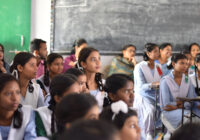There is something gravely wrong with the way India’s schools teach history. Rote, passive learning and politicized curricula asphyxiate interest and critical thinking.
Indian history students memorize events and dates without discussing or analyzing them. This habit goes back to the days of British rule (late 18th century–1947). After independence, India’s first Prime Minister Jawaharlal Nehru failed to reform this system. He pushed a curriculum that centered liberal values and Hindu–Muslim unity. This suited the political needs of a nation recently traumatized by the Partition between India and Pakistan, but it did not encourage students to think critically. Instead, their instructors expected them to accept the official narrative as gospel. More recently, Prime Minister Narendra Modi has shifted the narrative to emphasize the glory of ancient Indian and Hindu civilization. This a change in tone, but not a change in teaching style.
Kanchan Thakur, a history teacher with 32 years of experience, told me how “for years and years, the syllabus doesn’t change. Students are subjected to the same rut, [and] the pressure to finish the syllabus is huge.” As a result, 62% of students at government schools say they find history boring, while 57% struggle to understand lessons.
Obviously, unengaged students, and especially bored students, learn little. In a 2019 study, 40% of students interviewed remembered nothing about Partition, and most said they did not feel concerned about the event. This is alarming because the religious riots that Partition caused consumed 2–3 million lives, leaving a legacy of strained Hindu–Muslim relations and communal violence.
As troubling as these facts are, the failure to teach history well is not merely a failure to make students remember events. More fundamentally, it is a failure to build skills like communication and critical thinking. Today, Indian companies see around 54% of youth as unemployable due to their lack of these soft skills.
Students who lack communication and critical thinking skills make poor workers; they also make poor citizens. A rational, democratic society requires citizens who are aware of contemporary issues, are capable of reflecting on them and care enough about them to do so. Meanwhile, 46% of Indians born between 1981 and 1996 say that they lack interest in politics. This kind of apathy encourages voters to thoughtlessly support candidates based on distorted, partial understanding or caste and confessional loyalty. The result? 46% of newly elected members of parliament in 2024 had criminal charges against them.
A good history education, on the other hand, would these vital skills through practice.
How can India teach history differently?
History teaches young people to think about the present by training them to think about the past. Case studies in Indonesia and Saudi Arabia have shown that teaching students about history increases their engagement with present-day issues.
So, how can Indian instructors get their students in touch with history? The answer is active learning. Active learning is about asking questions, discussing and analyzing. It hinges on the application of analytical and communication skills — the very soft skills that Indian students need to develop.
Instructors can bring active learning into the classroom by replacing monologue with dialogue. Facilitating active discussions makes it easier for students to understand the causal connections that make history make sense, turning it into a flowing narrative rather than a staccato rhythm of dates and facts. As British author Rudyard Kipling once said, “If history were taught in the form of stories, it would never be forgotten.”
Instructors must also emphasize historiography — not just telling students one narrative, but explaining how different historians interpret sources and debate. This teaches students to think like historians, not just to accept their conclusions. This fosters a more critical attitude and reduces students’ vulnerability to distorted narratives. By doing so, as Cornell University writing professor Kelly King O’Brien and her coauthors have found, students gain the ability “not just [to] invoke generalizations about history (such as “history repeats itself”) but actually interrogate that history through a synthesis of sources.”
Schools also need to assign writing and research projects outside the classroom. Such projects give students the immersive experience of poring over multiple sources and constructing their own informed opinions. It also teaches them how to communicate their opinions clearly through writing, another vitally important soft skill.
However, changing teaching style alone would be futile without changing another aspect of the broader system — testing. Instructors’ internal assessments only make up 20% of a student’s final grade; the other 80% is a memorization-oriented board exam. So, students have little choice but to subject themselves to the drab, monotonous regimen of rote learning.
If testing does not reward active engagement, then students will make the rational choice not to put effort into it. Schools must recalibrate the incentive structure, both by giving more weight to internal assessments and by redesigning all exams to test meaningful skills.As historian James W. Loewen wrote in his bookTeaching What Really Happened, “Doing history is a verb.” To equip its youth with new skills that will power their development and the nation’s future, India must recognize this truth.
The views expressed in this article are the author’s own and do not necessarily reflect Fair Observer’s editorial policy.
Support Fair Observer
We rely on your support for our independence, diversity and quality.
For more than 10 years, Fair Observer has been free, fair and independent. No billionaire owns us, no advertisers control us. We are a reader-supported nonprofit. Unlike many other publications, we keep our content free for readers regardless of where they live or whether they can afford to pay. We have no paywalls and no ads.
In the post-truth era of fake news, echo chambers and filter bubbles, we publish a plurality of perspectives from around the world. Anyone can publish with us, but everyone goes through a rigorous editorial process. So, you get fact-checked, well-reasoned content instead of noise.
We publish 2,500+ voices from 90+ countries. We also conduct education and training programs
on subjects ranging from digital media and journalism to writing and critical thinking. This
doesn’t come cheap. Servers, editors, trainers and web developers cost
money.
Please consider supporting us on a regular basis as a recurring donor or a
sustaining member.
Will you support FO’s journalism?
We rely on your support for our independence, diversity and quality.







Comment